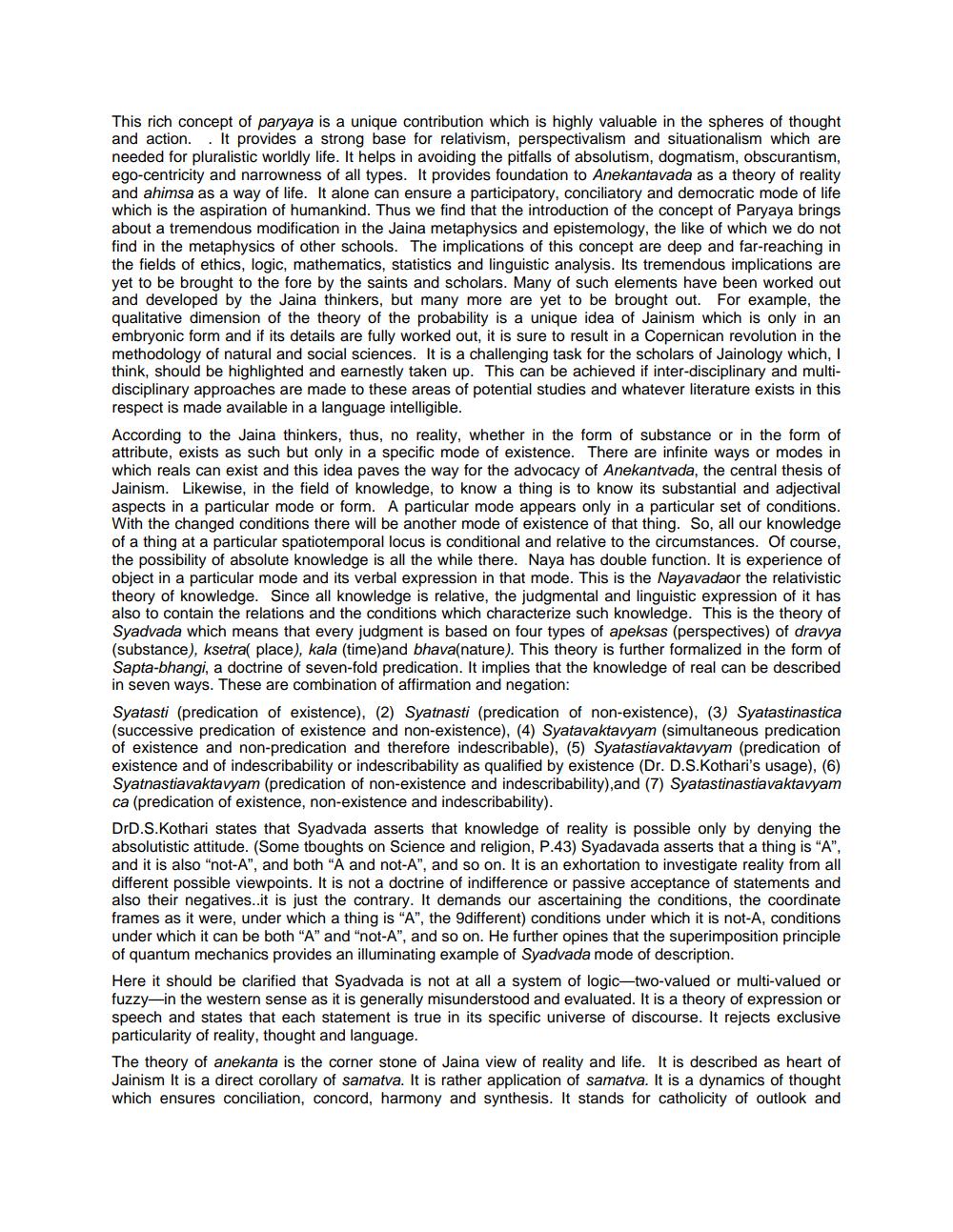Book Title: Jaina View Towards Philosophical Inquiry and Harmonious Ways of Living Author(s): S R Bhatt Publisher: ZZZ Unknown View full book textPage 7
________________ This rich concept of paryaya is a unique contribution which is highly valuable in the spheres of thought and action. It provides a strong base for relativism, perspectivalism and situationalism which are needed for pluralistic worldly life. It helps in avoiding the pitfalls of absolutism, dogmatism, obscurantism, ego-centricity and narrowness of all types. It provides foundation to Anekantavada as a theory of reality and ahimsa as a way of life. It alone can ensure a participatory, conciliatory and democratic mode of life which is the aspiration of humankind. Thus we find that the introduction of the concept of Paryaya brings about a tremendous modification in the Jaina metaphysics and epistemology, the like of which we do not find in the metaphysics of other schools. The implications of this concept are deep and far-reaching in the fields of ethics, logic, mathematics, statistics and linguistic analysis. Its tremendous implications are yet to be brought to the fore by the saints and scholars. Many of such elements have been worked out and developed by the Jaina thinkers, but many more are yet to be brought out. For example, the qualitative dimension of the theory of the probability is a unique idea of Jainism which is only in an embryonic form and if its details are fully worked out, it is sure to result in a Copernican revolution in the methodology of natural and social sciences. It is a challenging task for the scholars of Jainology which, think, should be highlighted and earnestly taken up. This can be achieved if inter-disciplinary and multidisciplinary approaches are made to these areas of potential studies and whatever literature exists in this respect is made available in a language intelligible. According to the Jaina thinkers, thus, no reality, whether in the form of substance or in the form of attribute, exists as such but only in a specific mode of existence. There are infinite ways or modes in which reals can exist and this idea paves the way for the advocacy of Anekantvada, the central thesis of Jainism. Likewise, in the field of knowledge, to know a thing is to know its substantial and adjectival aspects in a particular mode or form. A particular mode appears only in a particular set of conditions. With the changed conditions there will be another mode of existence of that thing. So, all our knowledge of a thing at a particular spatiotemporal locus is conditional and relative to the circumstances. Of course, the possibility of absolute knowledge is all the while there. Naya has double function. It is experience of object in a particular mode and its verbal expression in that mode. This is the Nayavadaor the relativistic theory of knowledge. Since all knowledge is relative, the judgmental and linguistic expression of it has also to contain the relations and the conditions which characterize such knowledge. This is the theory of Syadvada which means that every judgment is based on four types of apeksas (perspectives) of dravya (substance), ksetra place), kala (time)and bhava(nature). This theory is further formalized in the form of Sapta-bhangi, a doctrine of seven-fold predication. It implies that the knowledge of real can be described in seven ways. These are combination of affirmation and negation: Syatasti (predication of existence), (2) Syatnasti (predication of non-existence), (3) Syatastinastica (successive predication of existence and non-existence), (4) Syatavaktavyam (simultaneous predication of existence and non-predication and therefore indescribable), (5) Syatastiavaktavyam (predication of existence and of indescribability or indescribability as qualified by existence (Dr. D.S.Kothari's usage), (6) Syatnastiavaktavyam (predication of non-existence and indescribability), and (7) Syatastinastiavaktavyam ca (predication of existence, non-existence and indescribability). DrD.S.Kothari states that Syadvada asserts that knowledge of reality is possible only by denying the absolutistic attitude. (Some tboughts on Science and religion, P.43) Syadavada asserts that a thing is "A", and it is also "not-A", and both "A and not-A", and so on. It is an exhortation to investigate reality from all different possible viewpoints. It is not a doctrine of indifference or passive acceptance of statements and also their negatives..it is just the contrary. It demands our ascertaining the conditions, the coordinate frames as it were, under which a thing is "A", the 9different) conditions under which it is not-A, conditions under which it can be both "A" and "not-A", and so on. He further opines that the superimposition principle of quantum mechanics provides an illuminating example of Syadvada mode of description. Here it should be clarified that Syadvada is not at all a system of logic—two-valued or multi-valued or fuzzy-in the western sense as it is generally misunderstood and evaluated. It is a theory of expression or speech and states that each statement is true in its specific universe of discourse. It rejects exclusive particularity of reality, thought and language. The theory of anekanta is the corner stone of Jaina view of reality and life. It is described as heart of Jainism It is a direct corollary of samatva. It is rather application of samatva. It is a dynamics of thought which ensures conciliation, concord, harmony and synthesis. It stands for catholicity of outlook andPage Navigation
1 ... 5 6 7 8 9 10 11
